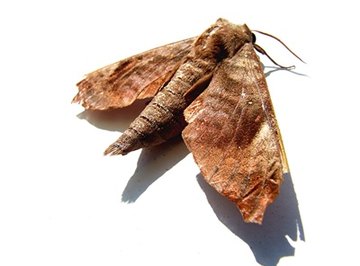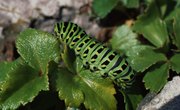
Moths are temperature-dependent insects. This means that the lifespan of a moth is longer or shorter depending on the environmental temperature. In cooler temperatures moths will take longer to develop, and in warmer temperatures, they will move through their life stages faster.
Types of Moths in Houses
There are several types of small, brown moths that can be found in houses located around the world. The brown house moth (Hofmannophila pseudospretella) is thought to have originated in Asia but is now found across Europe and North America and all the way down to New Zealand. Brown house moths grow to be between 0.31 and 0.55 inches long and have a wingspan between 0.59 and one inch wide. They are distinguishable by the three or four dark spots on their forewings.
A similar-looking species is the smaller, golden brown, case-bearing clothes moth (Tinea pellionella), which measures between 0.24 and 0.31 inches long and has three pale spots on its wings. The straw-colored common clothes moth (T. bisselliella) has a wingspan between 0.47 and 0.51 inches and lacks markings on its wings. The white-shouldered moth (Endrosis sarcitrella) has a distinctive white head and very mottled brown wings with a 0.24 to 0.39 inch wingspan.
Life Cycle of a Moth
Like butterflies, moths undergo a complete metamorphosis. This means they have four life stages, and the larval stage looks completely different from the adult stage. Their four stages are eggs, larvae, pupa and adult. During the egg stage, the moth embryo develops through a process called incubation to form a larva. Often the moth larva overwinters in its egg.
After hatching, moth larvae (often called caterpillars) feed voraciously. In houses, larval moths eat clothes, rugs and other fabrics. When they grow too large for their exoskeleton, they shed it off and then form a new one in a process called molting. The phase between each molt period is called an instar. When they have completed all their instars, they are fully grown and ready to find a safe space to pupate.
During their pupa stage, the larval moth's body reorganizes itself to become an adult moth. The moth is now mature and ready to reproduce. Male and female moths mate, then the female finds a safe space to lay her eggs, starting the whole cycle again. The number of eggs laid by a single female moth ranges from 106 to 657, with heavier females laying more eggs.
Lifespan of a Moth
Starting from an egg, the total lifespan of a moth ranges from 110 days to over 12 months, depending on the environmental temperature and relative humidity. At 50 degrees Fahrenheit, brown house moth eggs take 110 days to develop. When incubated at 80.6 degrees Fahrenheit, they hatch in only 8.5 days.
Relative humidity has a lesser effect: Eggs incubated at 77 degrees Fahrenheit take 9.5 days to develop at 90 percent relative humidity, and as many as 14 days to develop at 8.5 percent relative humidity. Survival of eggs is low in temperature and humidity extremes.
To survive, larvae need at least 80 percent relative humidity. In temperatures of 55.4 degrees Fahrenheit, larvae take 145 days to become a pupa, but at 77 degrees Fahrenheit, it only takes them 71 days. A pupa's development is affected by temperature, not relative humidity. At 50 degrees Fahrenheit, a pupa takes 98 days to develop, while at 82.4 degrees Fahrenheit, it only takes 13 days to become an adult.
The breeding success and lifespan of an adult moth depends on both the environmental conditions and their emerging weight after pupation. Female weights vary between 0.29 and 1.54 ounces, while males are typically smaller overall with less weight variation. After mating, female adults live between 9.4 and 11.9 days and males live around 7.1 days at 77 degrees Fahrenheit. At 59 degrees Fahrenheit, males and females live approximately 19 days.
References
About the Author
Adrianne Elizabeth is a freelance writer and editor. She has a Bachelor of Science in Ecology and Biodiversity, and Marine Biology from Victoria University of Wellington in New Zealand. Driven by her love and fascination with all animals behavior and care, she also gained a Certificate in Captive Wild Animal Management from UNITEC in Auckland, New Zealand, with work experience at Wellington Zoo. Before becoming a freelance writer, Adrianne worked for many years as a Marine Aquaculture Research Technician with Plant & Food Research in New Zealand. Now Adrianne's freelance writing career focuses on helping people achieve happier, healthier lives by using scientifically proven health and wellness techniques. Adrianne is also focused on helping people better understand ecosystem functions, their importance, and how we can each help to look after them.
Photo Credits
australian moth 15. image by mdb from Fotolia.com
